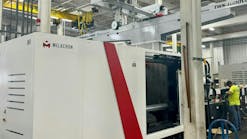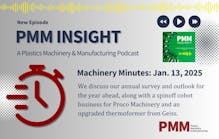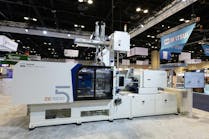Special Report: Advanced screw designs are redefining plasticizing technology
Improving the quality of the final product starts by getting the injection or extrusion process right. Several screw designers have developed offerings for better material mixing applicable to a range of processes.
IMPROVED PROCESSING WITHADJUSTABLE SCREW TECHNOLOGY
Plasticizing screws, whether designed for injection molding or extrusion, work best when they impart the correct amount of energy into the material being processed. "Higher melt temperatures experienced by the resin result in reduced physical properties. It takes energy to heat the polymers and also to cool them; therefore, a lower melt temperature reduces energy consumption, cycle time and line speeds. Lower melt temperature in virtually every way is a plus," says Robert Dray, president of R. Dray Manufacturing Inc., Dallas.
Dray, who has manufactured thousands of screws over nearly a half century, said that molders processing a range of materials with a general-purpose screw have had to rely on back pressure to improve mixing and dispersion. However, raising back pressure also increases melt temperature, lengthening cycle times.
Dray has developed a new all-purpose screw (APS) design that uses specially designed dams to modify the flow of material around the screw. This allows the processor to tailor the mixing effect of the screw to the material while keeping melt temperatures as low as possible. Users can alter the degree and type of mixing in the mixing section of the screw by switching out one or several of the dams, Dray said. Changing the distance of the dam to the barrel wall allows for the improvement in the mixing.
The dams fit into slots machined into the root of the screw that are held by cap screws. "Users have a screw design that can be modified at the site by removing the screw far enough to expose the removable dams and then replacing the dams as required. In this way, any change in polymer, regrind percentage or changes done to improve operating conditions can be accommodated on site," Dray said. He makes recommendations to the user regarding the dam height that will allow the customer to process a wide range of polymers on the same screw.
Dray has also developed other dam-based technologies for areas other than the mixing section of the screw. He patented an adjustable dam that is inserted into the melting section of the screw that allows for on-the-fly adjustments when material composition varies. (See related story here.)
The adjustable dam is suited to processing scrap for pelletizing or compounding. It controls the pressure in the primary channel of a barrier screw, forcing material together under pressure to make the polymer denser, which results in more efficient transfer of heat and more uniform melting. Changing the height of the dam modifies the pressure on the material, which impacts viscosity, flow rates and melt quality.
Dray also developed a removable dam that is incorporated into the feed section of a grooved feed extruder to modify the pressure profile of the incoming material. This removable dam is patented and can also be installed at the end of the primary channel section. Dray said interest in the technology has been growing the last two years among blown film processors.
Dray said users can purchase or modify an existing general-purpose screw with the APS mixing section, or with the removable dam technology in the melt section. Users can also purchase a new screw with the technology. Users can incorporate APS and either the adjustable or removable dam technology into a single screw design, depending on the process.
ADD LSR MOLDINGWITH RETROFIT PACKAGE
Nordson Corp., Polymer Processing Systems, New Castle, Pa., has developed a complete screw and barrel package for processing LSR that can be retrofitted to a standard injection molding press.
The new Xaloy LSR package, introduced at Chinaplas in April and available globally, comprises a specially designed screw, barrel, seal, valve and nozzle. It meets the special mixing and metering requirements of low-viscosity thermoset materials, and can be readily retrofitted on any standard thermoplastic injection molding machine, according to Mark Colella, global product manager for Nordson's Xaloy brand.
A single-flight, wear-resistant screw with L:D ratios between 12:1 and 14:1 provides optimum homogenization of the catalyst and crosslinking agents, and is designed to handle the materialswithout increasing the temperature of the com-pound.
Nordson designed the barrel with two welded cooling jackets and a feed port that's been moved further downstream. It provides the intensive cooling required to hold the LSR below its crosslinking temperature. The barrel inlay is made from Xaloy X-800, the company's nickel-based alloy with tungsten carbide that provides abrasion- and corrosion-resistance, needed when certain LSR compounds are processed.
The retrofit package also comes with a rear seal that is installed on the barrel or as a seal ring on the screw shank. An Xaloy spring-loaded valve ensures immediate shut-off when processing low-viscosity LSR compounds. The system also incorporates a shut-off nozzle.
Nordson recommends the retrofit LSR package for manufacturers of seals, gaskets, cushioning pads, medical devices, baby bottle nipples and kitchenware. Nordson can engineer customized packages to meet specific customer requirements, said Colella.
SCREW MIXING OPTIMIZEDTO THE MATERIAL
A mixing screw developed last year by Reiloy USA, Maize, Kan., that can be configured as a distributive or dispersive mixer with the change of several minor variables on the screw, has been upgraded with another adjustable feature that yields major process flexibility, according to President Dave Larson.
The as-yet unnamed screw, initially marketed with four areas of adjustment within the mixing section, adds a fifth level of adjustability that allows a processor to better dial-in a screw configuration suited to the material being processed. Changing these variables reconfigures the plasticizing screw so that it can impart either low or high shear. The molder can process materials as rheologically divergent as ABS and nylon with the same screw, said Larson.
By adjusting the barrier undercut, the design allows for a change in the compression ratio in the mixing section, or a change in the shear of the resin. Polymer flow can be controlled by adjusting the notches in the mixer section. Users also can adjust the number of flights in the mixing section.
"We have found another area of adjustment and that is the volumetric area of the mixer. We can change the root depth and that range of adjustment offers a greater effect of the mixer. The root depth can be altered in such a way that we are seeing a totally different result on melting and mixing," said Larson.
The new screw can accomplish any type of mixing needed by adjusting one, several or all of the variables. It is being beta tested at extrusion blown film plants, blow molding facilities and injection molding operations.
In addition to its new mixing screw, Reiloy and its sister company, Reiloy Metall, Troisdorf, Germany, are working to merge two designs to create a new commercial screw specific to blown film processing. The companies believe the new design will increase throughput 5-10 percent and trim horsepower needs by about 10 percent.
A new adjustable mixer style and a grooved feed section are being evaluated in the designs. Reiloy wants the screw to perform as both a distributive and a dispersive mixer so that it processes the melt effectively and also creates a stable bubble that is less susceptible to weak spots that can cause a blowout, Larson said.
SINGLE CONICAL SCREW DEBUTS
A conical screw is at the heart of a new single-screw micro-extruder that feeds, meters and melts standard pellets. The patent-pending conical screw micro-extruder has been developed by Tim Womer, a designer of thousands of single-feed screws for injection molding and extrusion. Womer is the owner of TWWomer & Associates LLC, an Edinburg, Pa., consulting firm.
"The issue with a small plasticizing screw is when its diameter is 1 inch or 1½ inches in diameter, one can only cut the feed section so deep before the screw becomes less robust and can break. A screw maker can incorporate exotic metal alloys and steels, but there is still a restriction in that the screw feed depth should not be cut deeper than 0.2 inches on a 1-inch diameter screw," Womer said.
The need to maintain a shallow root depth to preserve the integrity of the screw limits the size and number of pellets that can enter the feed section. In some cases, molders resort to purchasing micro-pellets, which are more expensive.
Womer's end-to-end conical single screw represents a departure from a crammer-type single screw that is conical at the top but transitions into a straight flight geometry with each passing flight. Conical screws featuring a flight O/D that tapers are typically used in twin-screw extruders to process PVC powders and recycled materials into plastic lumber.
Womer's conical screws have diameters between 0.75 inch and 1.5 inches on the feed end and 0.375 inch to 1 inch on the discharge end. "Optimally, it is a straight conical taper," Womer said. The micro-extruder is designed as a vertical extruder rather than as a standard horizontal extruder.
In the preferred design, the hopper is above the feed section of the screw and is much like an extension of the barrel and screw. This orientation allows standard pellets to fall onto the flight without obstruction.
"In this design, a user gets a micro-extruder with the feeding capacity of a larger screw unit. Instead of building the compression ratio [to melt the pellets] by varying the root geometry from deep to shallow, the root diameter of this micro-screw can be constant, and the flight outer diameter tapers to provide the compression ratio," said Womer. The conical-screw micro-extruder can process 2-20 pounds an hour of a standard PE, Womer said. The standard micro-extruder runs on 110 volts and can be plugged into a wall socket.
A FOCUS ON FLIGHTS
A screw that better manages the energy used to melt the polymer is the focus of two pending patents involving the Energy Transfer (E.T.) and Variable Barrier Energy Transfer (VBET) family of screws from Robert Barr Inc., Onsted, Mich. The design changes the leads and flight geometry in the melting section of the screw to reduce internal pressure, allowing for better material flow, said President Jeff Myers.
"The design principle on how this approach melts the material goes against conventional thinking with a standard, single-flighted, three-zone, compression-type screw. Reducing internal pressure is a major factor in the performance and wear of the screw. If we manage this better and maintain good melt quality, the life of the screw should increase without affecting performance," said Myers. The screw designs also will be available as an option, not only for Barr's E.T. and VBET screws but also as a retrofits with any conventional, single-flighted, general-purpose screw, Myers added.
Barr also is upgrading its Fluxion dynamic mixer for use as a stand-alone unit with its own drive control, to be used in place of a static mixer in extrusion. Fluxion has been available on the market for years as a shear-control device that is threaded onto the end of an extruder screw, where it performs as a cavity-type mixer. The rotor turns at the same speed as the screw that drives it, while the stator in the center of the unit acts as a floating ring and is not driven. The design provides a high degree of distributive mixing without adding excessive shear.
With the new configuration, the Fluxion mixer is mounted to the barrel of the extrusion unit rather than the screw. "The user can control the pumping pressure, the pressure drop and the shear. A user can tie the control of the speed of the rotor to a specific pressure or screw rpm, using it as another means to control melt quality," Myers said. The barrel-mounted Fluxion mixer is still in development, but the upgraded technology is expected to become commercially available at the end of the year.
Mikell Knights, senior correspondent
Contact:
Nordson Corp., 724-656-5600, www.nordsonpolymerprocessing.com
R. Dray Manufacturing Inc., 214-368-5424, www.rdray.com
Reiloy USA, 316-721-1144, www.reiloyusa.com
Robert Barr Inc., 517-759-5050, www.robertbarr.com
TWWomer & Associates LLC, 724-355-3311, www.twwomer.com








